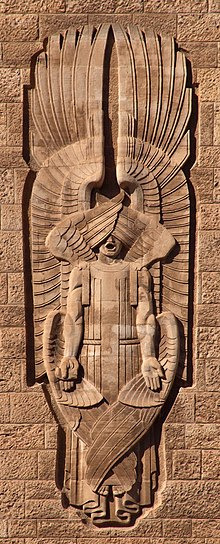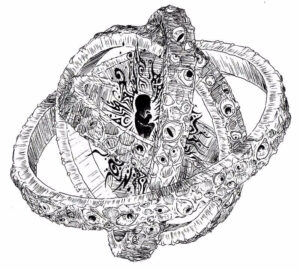Why Are Biblically Accurate Angels Scary
And the angel said unto her, Fear not, Mary: for thou hast found favor with God.” -Angel Gabriel to Mary, Luke 1:30 (KJV)
Sometimes angels appear as scary figures, which are much different from what we see as beautiful women or babies with feathered wings. They are usually thought as biblically accurate angels.
So, there has long been a joke that no wonder angels always started with “be not afraid”, because they usually looked scary.
Are you curious about what does biblically accurate angels look like?
What Is an Angel
The concept of “angels” originates from various ancient religions and mythologies, with their descriptions and roles evolving over time. The word “angel” itself derives from the Greek word “ángelos,” meaning “messenger.”
In the context of Abrahamic religions, such as Judaism, Christianity, and Islam, angels are typically considered spiritual beings who act as intermediaries between God and humanity, conveying messages, performing tasks, and serving as protectors or guides. Here’s a brief overview of how angels are viewed in these traditions.
Judaism
Angels, or “malachim” in Hebrew, appear throughout the Hebrew Bible (Tanakh), where they often serve as messengers of God. They also have roles in executing God’s will and offering guidance or protection to individuals. Well-known angels in Jewish tradition include Michael, Gabriel, and Raphael.
Christianity
Angels hold a significant place in Christian theology and are found throughout the Christian Bible, including the Old and New Testaments. They are often depicted as messengers or warriors of God, as in the Annunciation to Mary by the angel Gabriel, or in the Book of Revelation, where they play a role in the end times. Christianity also has the concept of guardian angels, each person having an angel assigned to protect them.
Islam
In Islam, angels (or “mala’ika” in Arabic) are considered to be made of light and are servants of Allah who carry out a variety of tasks. They are believed to be without free will, created to be obedient to God. Key figures among angels in Islam include Jibril (Gabriel), who revealed the Quran to the Prophet Muhammad, and Mikail (Michael), who is responsible for providing nourishment to bodies and souls.
Beyond these religions, the concept of benevolent spiritual beings similar to angels can be found in many other cultures and belief systems around the world. The details of their nature, the extent of their powers, and their interactions with humans differ widely across these traditions.
However, though angels are similar, angels are different in different religions and cultures. In this article, we will focus on angels that are defined by the Bible and Christianity works.
Depictions of Angels in Biblical Texts and Art
The appearance of angels is not often described in detail in the Bible, but some passages provide some information about their appearance. Here are several scriptures describing the appearance of angels, along with their original texts.
It should be noted that there are several types of angels in the Bible and they have their own distinct features.
Seraphim
In the book of Isaiah, seraphim are described as beings with six wings.
Isaiah 6:2-3 (KJV): “Above it stood the seraphims: each one had six wings; with twain he covered his face, and with twain he covered his feet, and with twain he did fly. And one cried unto another, and said, Holy, holy, holy, is the LORD of hosts: the whole earth is full of his glory.”

Cherubim
In the book of Ezekiel, cherubim are described as beings with four faces and four wings.
Ezekiel 1:5-6, 10 (KJV): “Also out of the midst thereof came the likeness of four living creatures. And this was their appearance; they had the likeness of a man. And every one had four wings. As for the likeness of their faces, they four had the face of a man, and the face of a lion, on the right side: and they four had the face of an ox on the left side; they four also had the face of an eagle.”

Creature with Many Eyes
Also known as ‘Ophanim’ and Thrones angels. Refer to Thrones of Angels: Meaning, Origins and Characteristics
The book of Ezekiel also describes a creature with many eyes.
Ezekiel 10:12 (KJV): “And their whole body, and their backs, and their hands, and their wings, and the wheels, were full of eyes round about, even the wheels that they four had.”

Human Shape
Angels are sometimes described as being similar in appearance to humans, with no special markings indicating that they are angels. No wonder ordinary people might confuse humans with angels.
Hebrews 13:2 (KJV): “Be not forgetful to entertain strangers: for thereby some have entertained angels unawares.”
The Reasons Behind the Scary Perception
We can see that Seraphim and Cherubim may have strange appearances which are from humanoids. The Bible does not say they are scary or not. However, these bizarre images may be the source of the scary images of angels.
We believe that the Bible does not deny these specific images, whether or not they are horrifying.
There are several explanations to explain what makes biblically accurate angels so scary.
Imposing Presence
Matthew 28:2-4 (KJV): “And, behold, there was a great earthquake: for the angel of the Lord descended from heaven, and came and rolled back the stone from the door, and sat upon it. His countenance was like lightning, and his raiment white as snow: And for fear of him the keepers did shake, and became as dead men.”
Ezekiel 1:13-14 (KJV): “As for the likeness of the living creatures, their appearance was like burning coals of fire, and like the appearance of lamps: it went up and down among the living creatures; and the fire was bright, and out of the fire went forth lightning.”
Angels are often depicted as messengers or warriors of God with a powerful and overwhelming presence. Their appearance is sometimes accompanied by intense displays of natural phenomena, such as bright light, fire, or thunderous voice, which can be frightening.
So it’s not hard to explain why angels have scary looks and images in some people’s imaginations.
Symbolism and Open Interpretation
Biblical descriptions of angels are often highly symbolic and open to interpretation. They may represent aspects of God’s majesty and the unimaginable spiritual realities beyond human comprehension. This can make the descriptions seem abstract and otherworldly, adding to the sense of fear or awe.
Rebellious Culture
Because Western culture has popularized a very sanitized, comforting image of angels, the more unusual biblical descriptions challenge our expectations and can evoke a fear of the unknown.
These scary angel images represent a rebellious culture that some people wants to challenge the traditional images of angels.
Cthulhu Mythos Influence
Inspired by the Cthulhu Mythos, some horror narratives have portrayed angels in a more terrifying light, often as inscrutable and potentially harmful beings. This is a stark contrast to their conventional representation as guardians and messengers of a benevolent deity. In these stories, angels might serve a higher purpose that is indifferent or even hostile to humanity, much like the cosmic entities of Lovecraft’s universe.
By drawing on the cosmic horror elements of the Cthulhu Mythos, modern portrayals of angels in horror culture often emphasize their alien and incomprehensible nature. They are presented as beings that exist beyond human understanding, with motivations that can be as terrifying as any monster or demon, thus bringing a sense of cosmic dread to the concept of angels.
Artistic Interpretations
When artists attempt to create visual representations of these descriptions, they often emphasize the strangeness and otherworldliness of the beings, which can produce eerie or unsettling artwork.
Conclusion
In conclusion, not all biblically angels are scary, at least for those angels of human shape. As we reflect on the terrifying truth about biblically accurate angels, we unravel a complex tapestry of fear and fascination. The enduring appeal of scary angelic beings continues to captivate and intrigue.
Also, the integration of religious symbolism and art into popular culture has created a lasting impact on society. From the silver screen to literary masterpieces, scary angels have left an indelible mark on popular culture. Their portrayal in movies, TV shows, and literature has shaped societal beliefs and perceptions. The allure of terrifying angels has become a captivating fascination, weaving its way into the fabric of our modern imagination.
These descriptions illustrate the diversity and mystery of angels in the Bible. In artistic depictions, these descriptions are often further romanticized and symbolized to suit the aesthetic concepts of different cultures and eras.


Well when I was dead for 2 weeks to describe myself I kind of look like a cartoon because I didn’t have a body.
I just had a head.
Look like a Jack in The box basically just a round ball with two eyes and funny looking hair.
It was completely black .
I couldn’t see nothing in any direction there’s all black.
The only other person are being that I seen I heard was my family and myself .
I could see everything going on in that room where I died at through a big old look like glass is waving waves in it and I was in the hospital room where they was disconnecting me from life support.
And then I heard a sound kind of like a transformer about to blow up humming behind me and I turned and looked and there’s a big bright beam of light it was so bright you couldn’t see nothing but around tube of light coming down and it stopped it’s just sit there humming with smoke looking clouds or something coming out of it and I Heard a voice which told me I was not supposed to be there for me to go back and finish my job I didn’t complete my job yet.
I couldn’t see a face or a body of nothing in that bright light coming down.
The light disappeared as fast as they come down.
I look back in the glass where I was at and I wasn’t there just my family.
I turned back around to look and see if I could see anything and there was nothing .
I remember when I was coming to in the hospital everybody’s taking off running screaming for some reason.
That voice never told me what my job was.
The doctor told me when I left the hospital I would not live no more than 2 years 3 at the very most if that much.
She told me I needed to get my affairs in order and try to enjoy what life I had left.
That has been over 18 years ago.
That doctor and for other doctors has died.
And nobody told me they dropped me out of the helicopter three times before getting me to the hospital.
I thought I was having a stroke they told me at the hospital when I come in.
Nobody mentioned when the helicopter took off they dropped me out of the helicopter pick me back up put me back in the helicopter and took off again and got up in the air and dropped me out again.
And when they was coming into the hospital to land on top of the helicopters pad at Baylor they dropped me out of the helicopter again before it landed.
I was wondering how come my neck and my back and my hip was hurting so bad when I was in the hospital I thought I had been in a car wreck or something.
Ghost there’s nothing to be scared of I don’t think they can hurt you.
But you can hurt yourself because you’re scared of the ghost you’re scared of the Dead are you scared of dying.
Immensely interested
& no, thank you
I am not fearful of death
I am curious of ascension
How to go further on,
further up